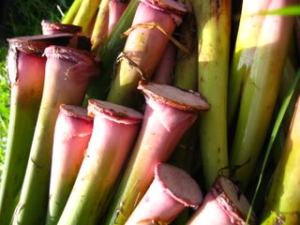


 Taro is grown as staple crop. It can be cultivated in upland and lowland areas. The cormels and corms are being baked, fried, boiled or roasted. It is also eaten as vegetables. Its leaves and petiole are good vegetables cook in selected palatable menus especially if cook with grated coconut.
Taro is grown as staple crop. It can be cultivated in upland and lowland areas. The cormels and corms are being baked, fried, boiled or roasted. It is also eaten as vegetables. Its leaves and petiole are good vegetables cook in selected palatable menus especially if cook with grated coconut.
It can be grown in all kinds of soil types. Best in a friable loam soil, well-drained land. It can be planted in moist environment, in rice paddies and even in your own backyard.
In lowland varieties, it can be grown submerge in water, in a rice paddies or areas where the soil is always moist. While the upland variety needed water occasionally during the period of its growth.
In lowland, clear the land. Flood the area. After 3 days, plow and harrow the land 4 times. Let the land stay in water 2 days before planting. The purpose is to soften the soil particles.
In upland, clear the land. Plow and harrow until the soil is loose and friable. Make furrows more or less 30 centimeters deep.
Use corms or cormels or stem cuttings as your planting materials. It is common to use stem cuttings that gives more yield compared to other types of propagation. Taro can be planted anytime of the year.
In highland culture, plant at the start of rainy season where irrigation facilities are available.
In lowland culture, where moisture is always available, use spacing of 60 cm x 60 cm between plants.
Compost or organic fertilizer can also be applied together with complete fertilizer (14-14-14) 2 weeks before planting. Apply the rate of 400-500 kg/hectare.
Fertilize the plants for rapid development of the leaves and normal enlargement of the corms. Apply compost to the soil to ensure fertility for fast growth of the plants.
In order to control the taro pests, use the commercial insecticides 7-14 days interval at the rate of 3 teaspoons in 4 gallons of water. This is to control leafhopper, mealy bugs, mites, grasshopper, and leaf roller.
Most of the diseases of gabi or taro are leaf blight and tuber rot. Control them with appropriate rate of fungicides. This is to additionally control other viral diseases.
Nematode infestation causes stunting of the plants, formation of galls in the roots and irregular swelling of the corms. Application of nematicides is the only solution.
Harvest the plants only when most of the leaves turn yellow. Lowland cultivars matures 9-12 months after planting. There are variety of taro that can be harvested within 7 months after planting.
Upland taro matures 5-10 months. Harvest during dry weather to easy for the plants to be lifted by pulling with the hands.
Avoid making any bruises to the corms. This will be the starting point for the corms to rot. Utmost care should be given during the harvesting period.
After harvest store in a well-ventilated place, those corms free from injury. It can be stored up to six months by maintaining the temperature of 7’c or 50’F. If lowest, the corms will decay in 8 weeks.